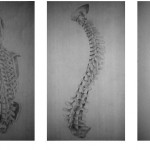About Pilates, Ribs and Spirals by Anna Schrefl
When we walk and run, turn, twist, bend forward or to the side, our spine needs to be flexible in order to allow these movements. In addition to the spine, our ribs need to have mobility as well.
In our Pilates training, we seem to be concerned with everything but the ribs: our Powerhouse (lumbar-pelvic area), our spine, shoulder girdle and hips, our extremities, head and neck. We tend to forget about the movement potential of our ribs and the importance of integrating them in the movement of our trunk.
Unfortunately, using the word “ribcage” implies that we might think of the ribs as one solid unit. Nevertheless, our “chest” (probably a better word choice than “ribcage”) is made for movement, for rotation and spiralling.
Structure: We have twelve pairs of ribs, each elliptically shaped and articulating with the thoracic spine. Seven “true” ribs (1st to the 7th) are also directly connected with the sternum, three “false” ribs (8th to the 10th) are indirectly connected and another two “false” ribs (11th and 12th, our “floating” ribs) are not at all connected to the sternum.
Here are some interesting details:
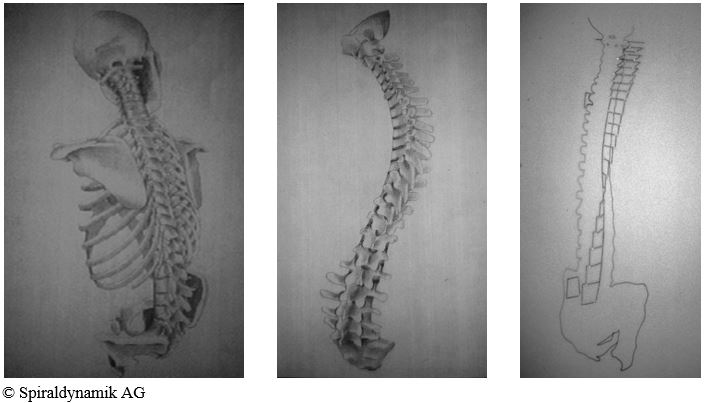
Our spine follows a spiral-like construction. The positions of the vertebrae´s facet joints are spatially changing along the spine. Whilst in the lumbar spine they lie in the sagittal plane, they change their orientation towards the frontal plane in the thoracic spine and towards the transverse plane in the cervical spine (see the third picture above).
Due to the structure of the thoracic vertebrae, this gives us about 55 degrees of freedom of movement to rotate our thorax (chest), compared to around 5 degrees in the lumbar spine – our thorax is made for rotations.
Most of our ribs are connected via two joints (articulatio capitis costae and articulatio costotransversaria) to the spine and one joint to the sternum (articulatio sternocostalis). Morphologically, most of these joints are categorised as arthrodial (plane) joints, firmly supported by ligaments. Though their range of motion is small, the number and form of the joints allow the chest a three-dimensional range of motion. The thorax is also equipped with a large external and internal oblique muscle system for rotation.
Organisation: The upper ribs (1st and 2nd) are muscularly connected to the head and neck, the lowest ribs (11th and 12th) are muscularly connected to the pelvis. From a functional movement perspective, we can note that the upper ribs are following the head, the lower ribs the pelvis.
The ribs are flexible and adapt to movements of the trunk and the chest. When we inhale, the external intercostal muscles are getting activated and the space between the ribs is getting wider. The upper ribs plus the sternum raise up, the lower ribs mostly widen to the side. When we exhale, the space between the ribs is narrowing again. When we bend to one side, the space between the ribs of this side is reduced as well.
Rotations are more complex:
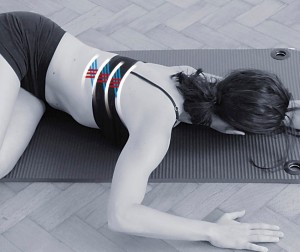
Rotating forwards
Ribs: the space between the ribs is getting wider, the curve of the ribs is slightly changing. The ribs are spiralling with the spine forward and up.
Muscles: The internal intercostal muscles (blue) are getting stretched, they need to lengthen. The external intercostal muscles (red) are getting activated and shorter.
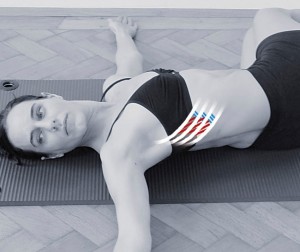
Rotating backwards
Ribs: the space between the ribs is getting more narrow, the curve of the ribs is slightly changing. The ribs are spiralling with the spine backward and up.
Muscles: The external intercostal muscles (red) are getting stretched, they need to lengthen.
The internal intercostal muscles (blue) are getting activated and shorter.
Training: In our Pilates training, we need to jump out of our “box” thinking. Rotations of the thorax and spine are essential for human movements and well-being. To train our Powerhouse, stabilising the lumbar-pelvic area and lengthening the spine, is a great way to start. The elongation of the spine is a prerequisite for the body to rotate and to spiral functionally correctly. But do not stop there – think about applying this to dynamic stability as well.
Creating length and elongation in our body and keeping this length and elongation where it is needed in response to different movement requests is a livelier way of dealing with stability. A twist/rotation of the spine needs stability as well – keeping the axis of the rotation centred, keeping an active support for the joints, and avoiding unwanted shearing forces.
Integration into daily life activities
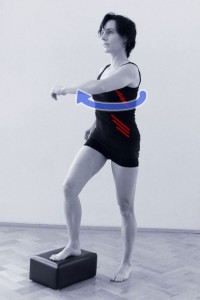
Walking, running, climbing stairs:
Our trunk is rotating and spiraling.
The upper ribs are following the head; the lower ribs are following the pelvis.
The ribs of the left side which is rotating forward (blue arrow) are “opening,” the ribs of the other side are “closing.”
The internal oblique muscle system (red lines) of the left side needs to lengthen to allow this movement.
Dynamic stability: The pelvis of her left side has to stabilize while the right pelvis moves forward (taking a step). The spine rotates, the ribs are spiraling forward and up (imagine a spiral staircase), the left arm swings forward (in the picture, the swing of the arm is exaggerated).
My Favorite Thorax Rotation Exercises
1) Reverse Tic Toc (with an elastic band)
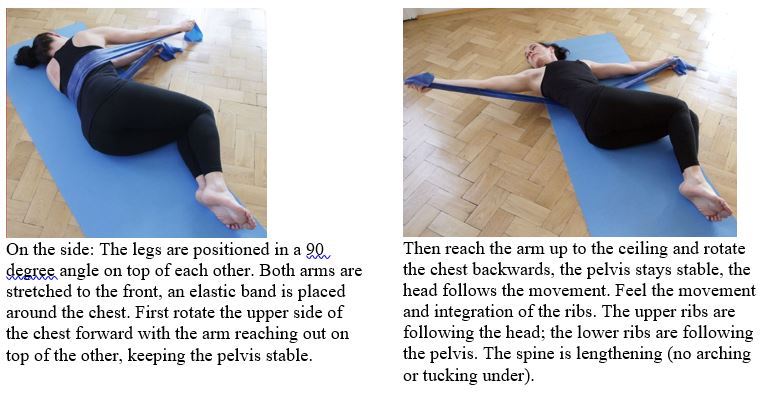
2) Reverse Tic Toc (with small weights)
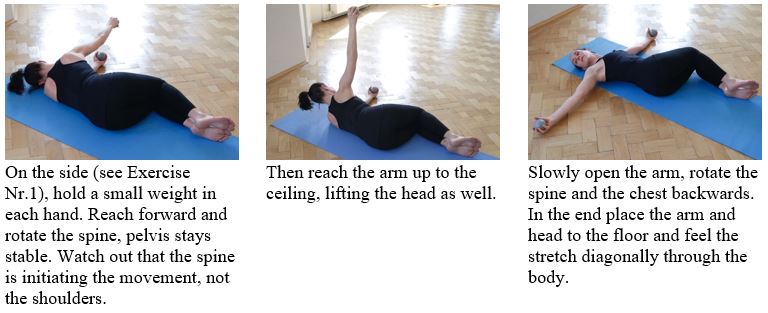
3) Criss Cross Variation
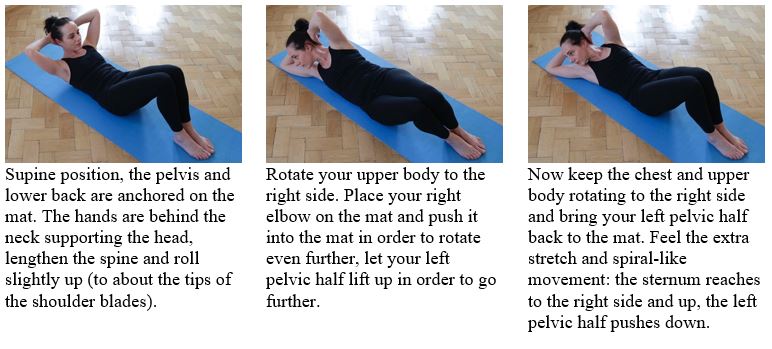
4. Sitting Twist Variation Number 1 (with an elastic band)
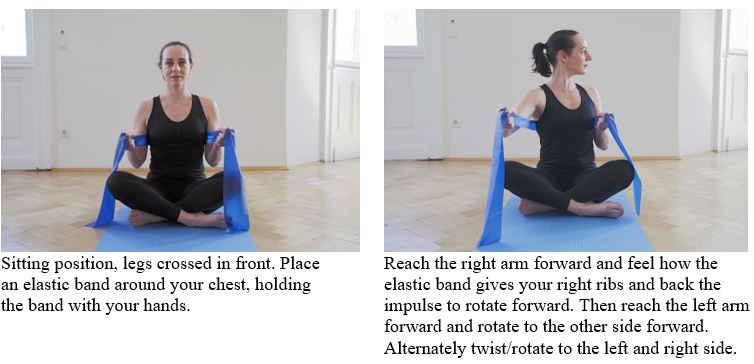
5. Sitting Twist Variation Number 2(with an elastic band)
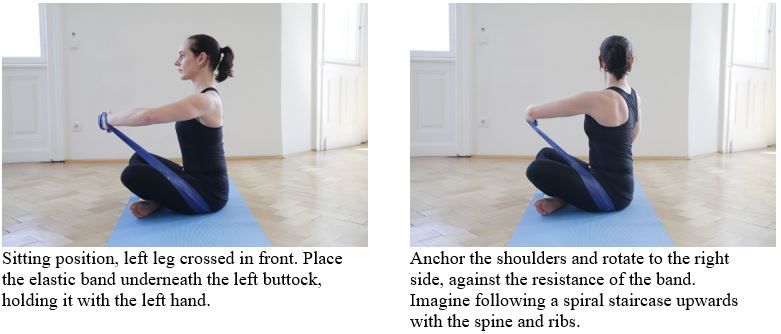
6) Cat Stretch with Rotations
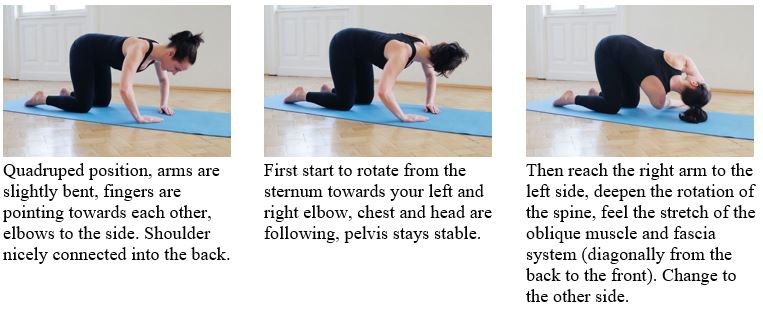
Text: Anna Schrefl
Model: Julia Hechenblaikner
Photography: Béla Baptiste
Illustrations: Friedrich Zaunrieth
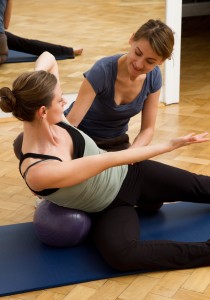 Anna Schrefl
Anna Schrefl
Anna Schrefl studied contemporary dance at the Amsterdam School of Arts and the Modern Dance Academy in Rotterdam. In 2001, she finalized her Pilates training in New York with Romana Kryzanowska. She completed her Pilates Teacher Trainer training under Ton Voogt and Michael Fritzke and established in 2006 the “Pilates System Europe – Certification Program” with the supervision of Ton and Michael. Anna teaches special seminars for Pilates trainers around Europe and also works as a freelance choreographer. Since 2013, she is a certified advanced specialist in Spiraldynamik® and is currently becoming a lecturer of the Spiraldynamik®. Since 2015, she takes part in the Master of Dance Science Programme of the University of Bern. Anna Schrefl is the director of Pilates System Europe® in Vienna.
Foto: Bluhm

